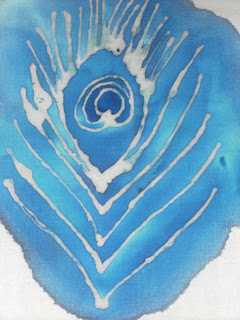I suppose you've got to experiement thought haven't you?
What I did was experiement with silk and cotton and scrap fabrics to expand my research. I used watercolour and ink to idnetitfy the shapes which in my opinion I prefer the ink as it gives a more effective outcome and secures the shapes successfully whereas watercolour fades and isn't as evenly spread.


 I found this pattern in a magazine and thought it would be an intricate design to copy. I thought my sample is quite accurate but could have been straighter and thinner lines with a slicker precision at the tips.This sample was experiemented on cotton and took roughly 10 minutes with a use of blue ink to reveal the pattern.
I found this pattern in a magazine and thought it would be an intricate design to copy. I thought my sample is quite accurate but could have been straighter and thinner lines with a slicker precision at the tips.This sample was experiemented on cotton and took roughly 10 minutes with a use of blue ink to reveal the pattern.Consequently, I wanted to try the same pattern on a different pattern so that's what I did!As you can see the pattern overpowers the Batik due to the fact the contrast of light and dark has been taking away.
 This sample was extracted from observational study one taken from the same section used for the collage in fabrics. I decided to change the areas so one was more negatively dominated and the other positiveley dominated.For this sample I used cotton but for the other I used silk to see how the properties differed.I brushed over it with brown ink to surround the colour but I don't think the colour is strong enough and quite weak. I would improve this by adding stitching or overlapping different fabrics to collect more detail as it's hard to identify what section it is.
This sample was extracted from observational study one taken from the same section used for the collage in fabrics. I decided to change the areas so one was more negatively dominated and the other positiveley dominated.For this sample I used cotton but for the other I used silk to see how the properties differed.I brushed over it with brown ink to surround the colour but I don't think the colour is strong enough and quite weak. I would improve this by adding stitching or overlapping different fabrics to collect more detail as it's hard to identify what section it is.
 I sampled observational study 3 and extracted the background outline of the sewing machine and used watercolour to reveal the wax. This was my weakest attempt but my first so I progressed through the lesson with more experience of using the Batik equipment.
I sampled observational study 3 and extracted the background outline of the sewing machine and used watercolour to reveal the wax. This was my weakest attempt but my first so I progressed through the lesson with more experience of using the Batik equipment.

REMEMBER: 3 easy steps to create a Batik sample
1. Sketch your design on a plain piece of paper.
2. Layer fabric over paper so you can see the design and follow lines filling with wax from the BatikTjantungs. Peel off paper.
3. Brush over pattern with inks or watercolour and hang up to dry.
HEALTH & SAFTEY
1. Be careful that was doesn't hit the surface of the skin.
2. Keep wax pot away from the wire preventing melting or burning.
3. Act responsibly whilst using Batik Tjantungs and equipment.
No comments:
Post a Comment